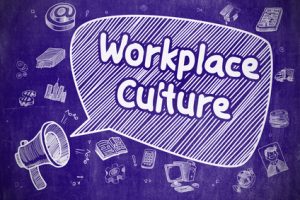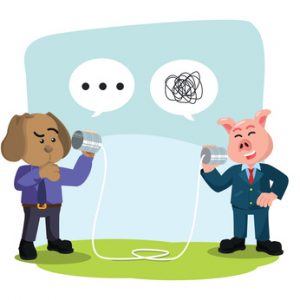The Importance of a Cultural Assessment For Your Company
 For today’s businesses, building a successful corporate culture has become a significant way to maintain a competitive advantage and differentiate a brand. Your culture can be a unique means to attract talent and also motivate, engage, and retain employees. For the last few months, we’ve taken a look at cultural values, both in society and the workplace. We’ve discussed what values are and why they’re so important. So, now you may be looking at your organization and thinking, “how do I define the culture in my particular office? And how do I take this culture and incorporate it into the day-to-day?” Conducting a cultural assessment is often what you need. It’s the first step in answering the question, “Is what we say we are, truly what we are?”
For today’s businesses, building a successful corporate culture has become a significant way to maintain a competitive advantage and differentiate a brand. Your culture can be a unique means to attract talent and also motivate, engage, and retain employees. For the last few months, we’ve taken a look at cultural values, both in society and the workplace. We’ve discussed what values are and why they’re so important. So, now you may be looking at your organization and thinking, “how do I define the culture in my particular office? And how do I take this culture and incorporate it into the day-to-day?” Conducting a cultural assessment is often what you need. It’s the first step in answering the question, “Is what we say we are, truly what we are?”
Conducting a cultural assessment includes reviewing the various components of culture, including environment, traditions, social relations, incentives, and values. Some of the following questions are examined: “Are employees happy in the space they’re in? Are workers communicative and social, both in person and online? Are the core values of the company filtering their way down to the employees in a clear manner? Are rewards offered through an employee reward system?” That’s just a sample of some of the areas that are explored. Through gaining this understanding, you can determine where gaps exist between the current state and the desired culture.
Often, organizations want or need to make changes, whether it’s shaping new behaviors, promoting new ways of thinking, or developing a culture of education to develop employees. However, the key to changing a company’s culture is a commitment from the leadership team. Leaders must understand why change is necessary and have a clear vision for making those changes. They must also be willing to change their own behaviors and actions!
I use the Barrett Values Center assessment tool to conduct cultural assessments for my clients. I find it to be the most comprehensive tool for understanding the current state of an organization’s culture and determining where changes are necessary. To learn more about the Barrett Values Center, visit their website as www.valuescentre.com. To schedule a time to discuss conducting a cultural assessment for your firm, call Leah M. Joppy and Associates at 301-670-0051 or email us at leah@lmja.com. Meaningful and sustainable change is possible.
Six Warning Signs Your Company May Need A Culture Overhaul
 It’s no secret that many of the best performing companies have vibrant and exciting cultures. Disney, Apple, and NIKE, we’re looking at you! On the flipside, a toxic company culture can cause an organization to struggle. Maybe you’re dealing with poor employee morale and high turnover and are wondering if your company’s culture is to blame. What are the warning signs that your company culture may be in trouble? Here are a few signs that it may be time for a cultural assessment:
It’s no secret that many of the best performing companies have vibrant and exciting cultures. Disney, Apple, and NIKE, we’re looking at you! On the flipside, a toxic company culture can cause an organization to struggle. Maybe you’re dealing with poor employee morale and high turnover and are wondering if your company’s culture is to blame. What are the warning signs that your company culture may be in trouble? Here are a few signs that it may be time for a cultural assessment:
- You routinely fall short of meeting goals and “underperformance” is a word tossed around all too often
- Employees aren’t demonstrating a strong commitment to the company and energy is can only be described as “low”
- Workers complain about a lack of positive feedback (or feedback at all)
- There’s a level of mistrust among employees and leaders
- Employees feel there is a lack of opportunity within the organization
- The level of job burnout is high and work/life balance seems to be nonexistent
Don’t wait until issues blow up into big problems. A cultural assessment is a vital step towards assessing the current culture of your organization and taking clear steps towards making purposeful and meaningful change. Outside perspective is invaluable in healing a poor company culture and the damage it can inflict. To discuss conducting a cultural value assessment for your business, please call Leah M. Joppy and Associates at 301-670-0051 or email us at leah@lmja.com.
What Are Cultural Values?
 The Business Dictionary defines cultural values as, “The commonly held standards of what is acceptable or unacceptable, important or unimportant, right or wrong, workable or unworkable, etc., in a community or society”. Here’s an example: A Hindu man would rather starve than slaughter and eat a cow, despite the fact that cows roam throughout his village. To the average beef-eating American, this seems strange. If you’re hungry, why not use some of the cows for a food source? After all, they’re just walking around in the street, blocking traffic. What’s stopping the Hindu man from taking advantage of this obvious food source? The answer – cultural values. The Hindus make up over 80% of India’s population and believe that cows are sacred and should not be slaughtered.
The Business Dictionary defines cultural values as, “The commonly held standards of what is acceptable or unacceptable, important or unimportant, right or wrong, workable or unworkable, etc., in a community or society”. Here’s an example: A Hindu man would rather starve than slaughter and eat a cow, despite the fact that cows roam throughout his village. To the average beef-eating American, this seems strange. If you’re hungry, why not use some of the cows for a food source? After all, they’re just walking around in the street, blocking traffic. What’s stopping the Hindu man from taking advantage of this obvious food source? The answer – cultural values. The Hindus make up over 80% of India’s population and believe that cows are sacred and should not be slaughtered.
A group’s cultural values are often difficult for outsiders to understand. But for those inside the group, cultural values are the core principles that dictate the behavior and actions of an entire community. We’re seeing cultural values come into play more and more in today’s workplace. As various cultures are brought together in an office, some will place importance on a particular set of values, while others will have a completely different view. It can be challenging to navigate through it all and meld a diverse pool of employees into a cohesive, productive group.
Each of us is raised in a belief system that influences our individual preferences to a large degree. Often, we can’t even comprehend its influence. We’re just like other members of our culture and we’ve come to share a common idea of what’s appropriate and inappropriate. But understanding cultural values goes beyond the list of “dos and don’ts”. There are so many factors that make up a culture – manners, mind-set, laws, ideas, rituals, and language, just to name a few. Understanding the “why” behind culture is so important, particularly in today’s world. We need to understand how groups have been influenced over time by political, historical, and social issues. This is particularly evident in the workplace, which is becoming more and more diverse.
In order to attract, motivate, and retain the best talent, it’s important to be mindful of employees’ cultural differences, along with who they are as individuals. We are currently conducting cultural value assessments for organizations and we’re ready to help you delve into this important topic. Please call Leah M. Joppy and Associates at 301-670-0051 or email us at leah@lmja.com to learn more.
Examples of American Cultural Values
 Cultural values are really the collective programming of our minds from birth. These values shape the beliefs, mind-sets, and practices that we often adhere to at work, home, and social settings. We looked at an example of a Hindu cultural value in our previous article and how that value shapes the beliefs, attitudes, and behaviors of that group. But what are some values that are distinctly American and have helped shape the American workplace for generations? The U.S. is a culturally diverse society, but there is a dominant culture that has developed over many years. Here’s a sample of a few American cultural values:
Cultural values are really the collective programming of our minds from birth. These values shape the beliefs, mind-sets, and practices that we often adhere to at work, home, and social settings. We looked at an example of a Hindu cultural value in our previous article and how that value shapes the beliefs, attitudes, and behaviors of that group. But what are some values that are distinctly American and have helped shape the American workplace for generations? The U.S. is a culturally diverse society, but there is a dominant culture that has developed over many years. Here’s a sample of a few American cultural values:
- Personal control over environment and destiny: The future is not left to fate and lies in our hands.
- Equality and egalitarianism: People have equal opportunities and are important as individuals, not based on the family they are from.
- Competition and free enterprise: Competition brings out the best in people and free enterprise leads to progress and success.
- The importance of time: The achievement of goals depends on the productive use of time.
- Change and mobility: Change equals progress, improvement, and growth.
When discussing cultural values, it’s important to remember there are no rights and wrongs. Chances are, each of us has been raised with a different set of values from our colleagues. Education is the key to understanding these differences, particularly when diverse groups of people are working together. To learn more about how cultural values shape your organization and to discuss conducting a cultural value assessment for your business, please call Leah M. Joppy and Associates at 301-670-0051 or email us at leah@lmja.com.
Effective Communication In The Workplace
 Have you ever walked out of a meeting scratching your head and wondering, “What was that all about? What exactly am I supposed to do? What’s the goal of our discussion?” We’ve probably all been there. It comes as no surprise that effective communication is one of the most important issues in the workplace. Strong communication helps everyone feel heard and understood, resulting in a positive, encouraging, and productive environment. On the other hand, ineffective communication causes ideas to fall flat due to lack of follow-through, frustration, and an overall decline in morale.
Have you ever walked out of a meeting scratching your head and wondering, “What was that all about? What exactly am I supposed to do? What’s the goal of our discussion?” We’ve probably all been there. It comes as no surprise that effective communication is one of the most important issues in the workplace. Strong communication helps everyone feel heard and understood, resulting in a positive, encouraging, and productive environment. On the other hand, ineffective communication causes ideas to fall flat due to lack of follow-through, frustration, and an overall decline in morale.
If you feel like your team is stuck in a communication rut or you’re just looking to improve your skills (and we all can!), here are some things to keep in mind and strategies to employ:
Give Undivided Attention: Whether it’s a group meeting or one-on-one, offering full attention to those you’re with goes a long way. How often have you had a conversation with someone who continuously looked down at his or her phone or seemed lost in another world? Lack of focus devalues conversations and causes people to tune out.
Remember to Listen: Listening may not sound like a component of communication, but it is one of the most important ingredients. Being an effective communicator means listening, as well as talking. It sounds easy, but it can take some practice. How often do you find your mind wandering during a meeting or a conversation? It can be helpful to keep a mental checklist of all the main points the other person makes. When the conversation is over, try to recall at least three important things the person said. Get in the habit of doing this until listening is second nature.
Be Mindful of How You’re Communicating: Body language and tone contribute a great deal towards the effectiveness of your message. Maintain a relaxed stance and facial expression, rest your arms by your sides rather than crossing them in front of you, and make eye contact. Remember that words only make up a fraction of your message.
Follow Up in Writing: A lot of information and ideas are thrown around during meetings and it can be challenging for everyone to remember what was shared. Prior to meetings, designate someone to take notes and then assimilate this information into a concise email. Having a follow-up and refresher is an important step to make sure everyone is on the same page.
Effective communicating is more than just talking; it’s about connecting with the people around you. It’s integral to team development, company culture, employee engagement, and innovative thoughts and ideas. If you’d like to improve the communication process in your office or are interested in doing a “wellness check”, we’re armed with lots of strategies and ideas to help. Please call Leah M. Joppy and Associates at 301-670-0051 or email us at leah@lmja.com to learn more.
Effective Communication With Remote Employees
 Remote work is becoming more and more common in the modern workplace and the number of remote workers is increasing every year. Technology has made it easier to embrace remote work, but it has also brought about new challenges when it comes to team communication. Here are some tips to help the wheels of communication keep rolling when you don’t work under the same roof:
Remote work is becoming more and more common in the modern workplace and the number of remote workers is increasing every year. Technology has made it easier to embrace remote work, but it has also brought about new challenges when it comes to team communication. Here are some tips to help the wheels of communication keep rolling when you don’t work under the same roof:
- Establish standards for communication to ensure everyone is on the same page.
- Make sure transparency is a priority. Share all documents, decisions, upcoming deadlines, etc. in one area.
- Find a balance between over-communicating and not communicating enough.
- Make sure new remote team members get to know the rest of the team via video chat.
- Use real-time communication technology.
- Be concise and get to the point at the beginning of messages!
- Always proofread and edit messages to avoid confusion.
- Give space when needed. If remote team members need to take a break from being accessible online to get something done, make sure they know they can do it.
Remote team members add another layer of challenge when it comes to workplace communication. But by using some strategic tactics, it doesn’t have to result in a communication meltdown! For more tips and advice on how to improve communication with remote employees, please call Leah M. Joppy and Associates at 301-670-0051 or email us at leah@lmja.com.
Common Causes of Miscommunication in Workplace Teams
“What did he/she mean by that?”
“I thought he/she was working on that!”
If you’ve ever been a member of a team in the workplace, the phrases above probably sound familiar. They’re all examples of common and frequent miscommunications and they can cause frustration, conflict between team members, and a serious roadblock to productivity.
A lot goes into running an efficient, positive team environment, but effective communication may be at the top of the list as the most important component.
Miscommunication can be blamed for a significant amount of conflict among workplace teams. It’s unrealistic to think all miscommunication can be prevented. After all, people are people and personality conflicts and differences of opinion are going to happen. However, awareness and understanding of the causes of miscommunication can go a long way towards decreasing the number and frequency.
Here are a few examples of the most common causes of miscommunication in the workplace:
- Making Assumptions: This is the number one cause of miscommunication in the workplace! It starts with assuming that a particular need is obvious, others view a problem the same way you do, or someone knows what to do. If people don’t feel comfortable asking questions or speaking up, issues can escalate quickly.
- Providing Only The Basics: It may save time to communicate only the bare necessities to team members up front, but you’re going to spend a lot of time cleaning up the results. Workers may be hesitant to speak up and just try to figure things out on their own – often with incorrect results.
- Using Confusing Body Language: Not all communication is verbal and a lot is conveyed through gestures, facial expressions, posture, and tone of voice. If someone is distracted or having a bad day, a simple request or statement can be easily misconstrued.
- Failing to Assign Ownership: Accountability is key and team roles must be defined and clearly understood. Otherwise, it can lead to workers dumping duties on others, incorrectly assuming another worker was responsible for something . . . and the list goes on and on.
Language is a tricky thing. It can be difficult to interpret at times, resulting in little misunderstandings that can quickly escalate into big problems. Is your team suffering from miscommunication issues? Or are projects running fairly smoothly, but have room for improvement? Please call Leah M. Joppy and Associates at 301-670-0051 or email us at leah@lmja.com and we’ll work with you to create a clear and effective communication strategy for your workplace teams.
Ways To Alleviate Miscommunication
 If you’ve ever led or been a member of a workplace team, you’ve probably witnessed (or been involved in) a variety of miscommunication issues. What started as a simple question or concern may have quickly ballooned into a full-blown problem, resulting in frustrated, angry teammates. And you’re left scratching your head wondering how things got out of hand so quickly. Miscommunication is one of the biggest problems facing workplace teams and can cause missed deadlines, an erosion in morale, and higher turnover. Fortunately, it can be alleviated with the right approach. Here are some suggestions to help:
If you’ve ever led or been a member of a workplace team, you’ve probably witnessed (or been involved in) a variety of miscommunication issues. What started as a simple question or concern may have quickly ballooned into a full-blown problem, resulting in frustrated, angry teammates. And you’re left scratching your head wondering how things got out of hand so quickly. Miscommunication is one of the biggest problems facing workplace teams and can cause missed deadlines, an erosion in morale, and higher turnover. Fortunately, it can be alleviated with the right approach. Here are some suggestions to help:
- Address issues immediately and openly: Ignoring a workplace conflict will only make it fester. Address any issues right away and make sure you’ve gathered facts from all parties involved.
- Set Clear Expectations: No one is a mind reader. Set expectations early, make sure all questions are answered up front, and be available for clarification as the project progresses.
- Improve Your Listening Skills: Make sure it’s not “in one ear and out the other.” Active listening is an undervalued skill, but it can have a huge impact on how often conflicts arise.
- Recognize and Respect Personal Differences: Keep in mind that everyone can interpret the same thing in a different way. Understanding how the members of your team communicate can help you diffuse any potential problems.
Miscommunication can happen anywhere at any time, but awareness of the problem and a strong plan can help put everyone back on track. The key is to give your team the right conditions to develop and grow. If nurturing a healthy team culture is important to your workplace, please call Leah M. Joppy and Associates at 301-670-0051 or email us at leah@lmja.com and let’s work together to make it happen.
How To Practice Kindness in the Workplace
 When we think about how to optimize success in your workplace, compassion isn’t always the first thing that enters our mind. We talk more about things like increasing efficiency, sales numbers, and billable hours. But studies show kindness makes good business sense and there’s a lot of research showing some pretty compelling numbers. For example, employees of companies described as having kind cultures perform at 20% higher productivity levels, are 87% less likely to leave their jobs, and make fewer errors, saving their companies time and money. The companies themselves have 16% higher profitability.
When we think about how to optimize success in your workplace, compassion isn’t always the first thing that enters our mind. We talk more about things like increasing efficiency, sales numbers, and billable hours. But studies show kindness makes good business sense and there’s a lot of research showing some pretty compelling numbers. For example, employees of companies described as having kind cultures perform at 20% higher productivity levels, are 87% less likely to leave their jobs, and make fewer errors, saving their companies time and money. The companies themselves have 16% higher profitability.
Whether you’re a manager or an entry-level employee, there are many ways to bring kindness into the workplace. Here are a few simple ideas:
- Get to know your colleagues
- Offer guidance to a co-worker
- Build a collaborative environment with idea sharing
- Check the motivation behind your words, decisions, and behavior
- Acknowledge co-workers’ strengths and positive characteristics in front of others
- Lend a hand to someone who is under a tight deadline
- Encourage employees to openly communicate and share their thoughts
- Organize occasional teambuilding activities and have co-workers submit ideas and suggestions
Creating a culture of compassion in the workplace is where many successful companies are placing their attention. And rightfully so. For ideas as to how to incorporate more kindness into your company and reap its many benefits, please call Leah M. Joppy and Associates at 301-670-0051 or email us at leah@lmja.com to discuss how we can help. And stay tuned for March’s newsletter, when we provide a really fun “get to know your co-worker” activity you can use in your office!
What’s Important To You In 2018?
 A shiny new year is upon us, ripe with possibilities and opportunities to make changes. Most of us spend at least some time reflecting on the events of the previous year and what we can do to make improvements over the next 12 months. But too many of us are overwhelmed, disconnected, and feel like we’re going through the motions without a lot of purpose. It can be challenging to figure out what’s truly important in life and even more challenging to make an action plan for change.
A shiny new year is upon us, ripe with possibilities and opportunities to make changes. Most of us spend at least some time reflecting on the events of the previous year and what we can do to make improvements over the next 12 months. But too many of us are overwhelmed, disconnected, and feel like we’re going through the motions without a lot of purpose. It can be challenging to figure out what’s truly important in life and even more challenging to make an action plan for change.
If you’re determined to live a more purposeful life in 2018, now may be the time for a “life audit.” It’s a chance to be honest with yourself, think about what’s really important to you right now, and organize your life a little more. So, grab a pen, a pack of post-it notes, and block off an hour or two of time. Here’s how to get started:
- Write down every goal, hope, and life necessity on a different post-it note (for example: ‘look for a new job’, ‘move to a different city’, ‘start a family’)
- Organize the notes by category as themes start to emerge (for example: career, family, hobbies)
- Organize by time (for example: how long it will take to check-off each note)
You may want to set a goal for the number of post-it notes you fill out. Maybe it’s 100 in one hour or more over the course of a weekend. It’s not a revolutionary system, but the point is that you’re thinking about yourself, your future, and how to reach your goals. If you feel like you’re at a loss getting started, here are some questions to ask yourself:
- What life do I want now? How about in 5, 10, 25 years?
- What makes me feel satisfied at work?
- What areas of my life could be improved?
- What’s my motivation?
- What do I believe in?
- What do I consider essential?
- When do I feel the most successful? The most energized?
- How am I using my gifts and talents to help others?
- What is my purpose?
- What do I want to leave behind?
The great thing about writing all of this down on post-it notes is that you can hang them on a wall in your office (or wherever you’d like) and look at them everyday. You can move them around into an organizational system that works for you, perhaps by weekly, short term, long term, and lifetime goals.
A New Year is the ideal time to look at long term goals, what’s working, what’s not, and where there’s room for improvement. And we can help you every step of the way! Please call Leah M. Joppy and Associates at 301-670-0051 or email us at leah@lmja.com to discuss your organization’s 2018 goals.
